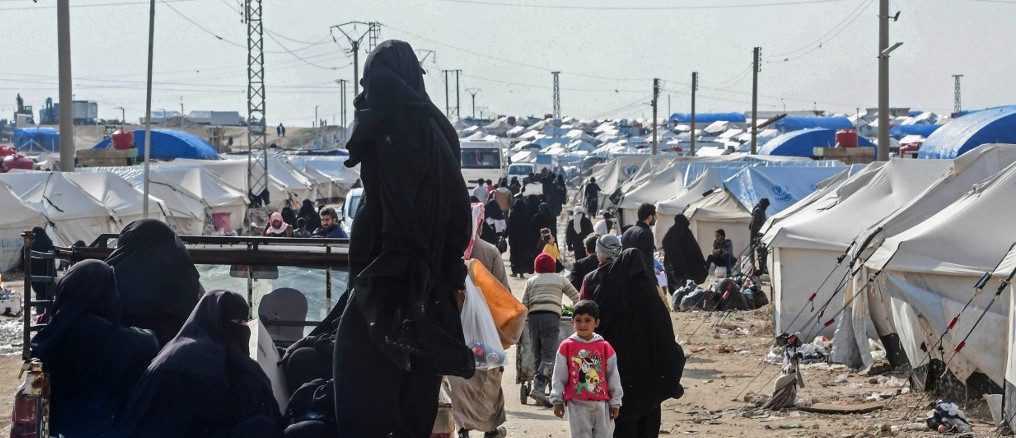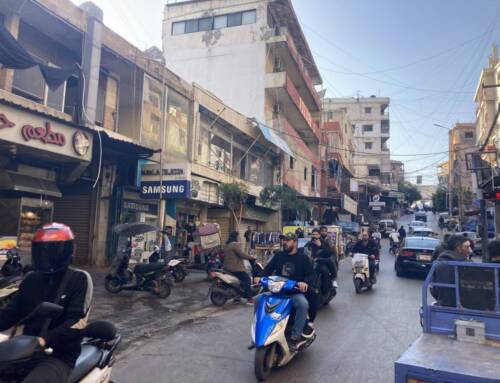‘Unlike any other camp’: A journey through al-Hol, holding center for thousands of IS families
Al-Hol camp is the international community’s temporary solution to a growing crisis: the question of what to do with women IS members and their children born under the hardline group’s rule.
17 April 2019
Women ride on a pickup truck in al-Hol camp in northeastern Syria’s Hasakah province on March 28. Photo by Giuseppe Cacace/AFP.
The camp looks out over the dusty, crater-filled center of the small Hasakah province village of al-Hol, its entrance guarded by vigilant Kurdish security forces.
Flanked by a contingent of workers from the Kurdish Red Crescent (KRC), aid worker Anita Starosta entered the gates last week—confronted by the massive reception area of al-Hol camp. It’s a space of chaos and desperation, overflowing with queues of women left behind by the Islamic State (IS), clad almost universally in black niqabs with trails of visibly injured children in tow.
This is the holding facility for what remains of the hardline Islamist group’s self-proclaimed “caliphate”: its former citizens. Endless rows of tents, bursting over capacity with upwards of 73,000 women and children, al-Hol camp is the international community’s temporary solution to a growing humanitarian and legal crisis. At the center of it is the question of what to do with the women IS members and their children born under the hardline group’s rule.
On her recent visit to the camp with the German NGO Medico, intended to lay the groundwork for construction of a new field hospital, Starosta was struck by the staggering shortages in medical care and unmet necessities at the KRC-administered center.
One woman rushed up to Starosta in the reception area and, in perfect English, implored her for help to return to her home country.
“I only saw her eyes,” she tells Syria Direct’s Barrett Limoges. “I don’t know where she was from, but clearly she was from another part of the world.”
The territorial defeat of IS was hard won, through years of brutal bombardment and vicious street battles across eastern Syria, as well as Iraq. But a new crisis is building—with tens of thousands of women and children left behind.
According to Starosta, they are being abandoned in an environment where radical sympathies are left to fester and grow.
“If the international community does not come up with a solution, the situation will stay like this,” she says. “These people will stay in al-Hol for years.”
Q: Could you describe entering the camp?
When we arrived at the camp, we first passed the entire village, which was under [IS] until 2015 and freed by [US-led] coalition airstrikes at that time. So there was still an IS prison, still the place where they did executions. There were still IS tunnels that you could see.
It was just a small village, but also very important for IS. There are a few hills, so it was a very strategic place for them.
When we entered the camp it was clearly overcrowded. It was a very strange mood—not aggressive, but hard to describe.
Also, everywhere we were seeing women and children who were injured and tired. It was different from any other refugee camp I have been to, definitely.
Q: Were you free to communicate freely with people in the camp?
We could talk to them. The first interaction stands out to me in the reception area—one woman [speaking] in perfect English. I don’t know where she was from, but she came to me seeing I was clearly a western person, and she was asking me if I was from the International Red Cross, [saying] that she lost her husband and kids, and asking if I could help her.
Then another woman came and asked if I knew where her husband was. I think a lot of women had lost their husbands in battle or they had been IS fighters who were now captured.
Interactions like this are never easy.
Q: Who is actually being housed in al-Hol camp?
Syrians, a lot of Iraqis, a lot of people from Turkey. We were in the reception area where all the people who arrive must stay first to get a first medical check and wait until they get their own tent.
In this reception area we saw a lot of [foreign] children, but not Europeans—I think they put them directly in the international section.
Q: Who is actually being held in this international section?
Well, everybody: German, Belgian, French, British, Americans, Russians, Sudanese, Algerian. They said [there were] about 50 nationalities. I don’t know where else a place like this exists.
Q: Does it feel like other camps that you’ve visited?
It’s a refugee camp, not a high security prison. I have been in other refugee camps in this region and it looks the same. You have security forces at the entrance, but we could move easily without any security forces through the camp.
For sure, the international section is held by military security forces—this is a special area.
But the rest of the camp, for me, it was like a refugee camp I saw in this region last year. It is not allowed for people to leave the camp, but they told us they can receive visitors twice a week.
Q: There have been widespread reports of overcrowding in al-Hol—is that immediately evident when touring the facilities?
Yes it is, but I think the situation is actually stabilizing. Although, especially in the health care area, there are hundreds of women waiting to go to the doctor and the nurse, so there is still overcrowding. The reception area is now as overcrowded as it was a few weeks ago.
There are [also] still people in tents with 20 or 30 other people, waiting to get their own tent. One woman talked to us who came from the Baghouz area. She has 13 children and her husband [either] died or is not with her. She waited 20 days in the reception area to get her own tent.
Also, the local staff and NGO people are trying their best—working 24 hours in the health section—but they still need money and really need more support.
Q: Is there any clear system to organize or separate different groups of people in the camp?
The Iraqi people are in one section, because many of them have been there for a while. [There’s] the idea—although it’s still just an idea—to send them back to Iraq.
All the people who [recently] arrived there are from Baghouz area—people who were traveling with IS and were there at the end of the caliphate.
Q: Did you notice any problems with aid provision during your time in al-Hol?
There is access to aid. [People inside the camp] can go to this KRC health point and there’s also one other health point. So two in the whole camp.
They are also now constructing a new hospital, and one NGO is willing to construct another hospital in the camp. But there is a lag for sure. I saw a lot of people with open wounds who needed operations.
What the KRC does is, if someone is really in need of aid, they bring them to hospitals in Hasakah or Qamishli. But most of these hospitals are full now, because the local populations there [also] need healthcare. So this is a really huge problem that there are no local hospitals anymore where they can bring people.
Q: You also visited a Kurdish village a few hours from al-Hol. Can you talk a little about that experience after visiting the families of IS fighters?
The day after we went to al-Hol camp, we visited the Yazidi community in al-Muda. [There] they have a house—the “Yazidi House” it’s called—where they receive the women and children who were captured by IS. They are trying to reintegrate them into the community. And there we met three girls who were captured by IS.
They used to speak Kurdish, now they almost don’t speak Kurdish anymore. They only speak Arabic. [The girls] lost their [parents], so they are orphans now. They were between four and seven years old, so it was incredible to hear what they had suffered under IS, they had lived in IS families. They also told us horrible stories about what they had suffered.
The Yazidi boys who came were totally indoctrinated by IS. They don’t want to see women. They would say, ‘Go away, we don’t want to speak to you without a burqa,’ things like this. They were Yazidi boys, but now totally indoctrinated by [IS] ideology.
So there is a huge question of what to do with these boys.
Q: Do you feel that the situation in al-Hol is sustainable, or that there’s contingency-planning being done there to prepare for the future?
There are two ways to answer this question. First, [there’s] the humanitarian situation, which has stabilized but health care is needed. I really want to call on international governments to support the KRC because they need that help on the humanitarian question.
But on the other hand, the big question is what to do with all the people who have been radicalized by [IS], [especially] all the children radicalized by [IS]. There are women who are still absolutely into the ideology, who said they were following the orders of [IS leader] Abu Bakr al-Baghdadi, who told them to go to the camp and create a new caliphate there.
There are also women who say they regret everything, that they just want to go back to their homes and their [origin] countries.
For sure, hundreds of women are still absolutely radicalized and there are children who grew up [aspiring] to be [IS] fighters. They really need psychological work and pedagogic programs to ease them back into normal life. Otherwise, there will be a new generation of terrorists growing up in the camp.
I think [there] has to be an international solution. All the people we talked to said they were not able to manage the situation in this way. They don’t have the knowledge, they don’t have the money, and they just don’t have enough people to [ensure] that terrorist [sympathies] won’t continue to build in the camp.
Q: While there’s still a lot of discussion about what to do with IS women and children, what sense do you have from on the ground that things could change in the foreseeable future?
If the international community does not come up with a solution, the situation will stay like this. These people will stay in al-Hol for years. There is an effort to get the Iraqi people sent back to Iraq, there is also an idea to create an additional camp to hold around 20,000 people, just to reduce pressure. If the international community will not take back these women and children, they will just stay there.
Also there are people, Syrian people from Homs, Idlib, Aleppo, who can’t be sent back to regime areas, so they will also stay there.
However, they said that those who lived in the Baghouz areas and were not part of [IS], that they can go back in a couple of months when the area is clear of mines.
They are now rebuilding, but the area is totally destroyed.







